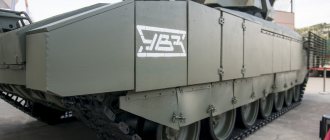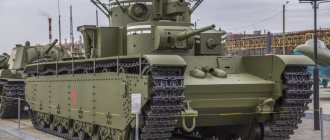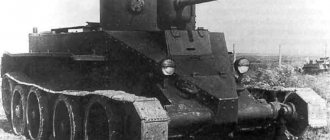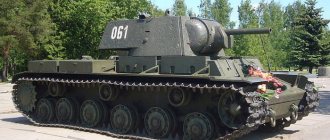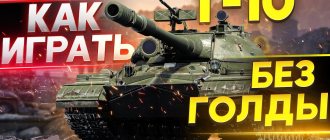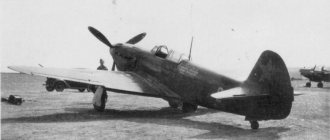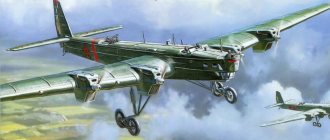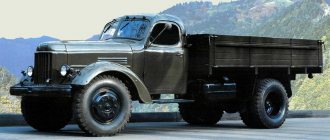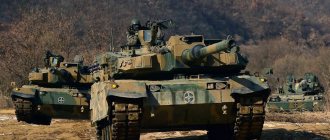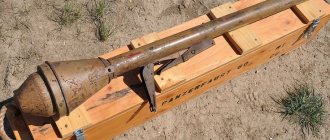On December 18, 1941, the first T-34 tank rolled off the world's first tank assembly line. This is how the history of tank building began at Uralvagonzavod, which today is part of the Rostec State Corporation and still remains the flagship of the industry.
The Soviet T-34 became the most popular tank of World War II - over 55 thousand vehicles of various modifications were created during the war. Every second of these tanks was assembled by the hands of Ural craftsmen.
To mark the anniversary, we are telling interesting facts from the history of the “thirty-four”.
2/ Trials at the cost of life
Column of T-34-85 tanks of the 2nd Far Eastern Front
In March 1940, Koshkin personally took part in a test run on experimental “thirty-fours”. Two tanks traveled under their own power along the Kharkov-Moscow route and reached the Kremlin, where the country’s leadership was shown the new vehicles. The run, which took place in difficult conditions and with increased secrecy, cost Mikhail Koshkin his life - the designer caught a cold and soon died before seeing the military triumph of his brainchild. The story of the run became the basis for the Russian feature film Tanki, released in 2022.
Tank is people
As you know, one of the creators of the T-34 tank, M.I. Koshkin, did not live to see the finest hour of his brainchild: he died in September 1940 from pneumonia, which he contracted after a long stay in a cold armored vehicle, in his “thirty-four”, during the mentioned run to Moscow in March of the same year. The death of the outstanding designer practically coincided in time with the start of mass production of his tank - the result of three years of hard work by the entire plant team, who sincerely experienced such a difficult loss: Mikhail Ilyich was truly loved and immensely respected at the enterprise.
He was buried at the First City Cemetery of Kharkov. The grave was destroyed in 1941 as a result of targeted bombing by Luftwaffe pilots (angried by the successes of the Soviet tank, Hitler declared Koshkin his personal enemy even after his death...)
But still, Mikhail Ilyich cannot be called the only and main creator of the tank: the car was created as a result of painstaking and intense work by the team of the design bureau under his very competent leadership - the leadership of a brilliant organizer and talented designer who managed to create an amazing creative atmosphere in the team, full of daily ideas and rationalization proposals. But it was their symbiosis with A. A. Morozov, his right hand, who replaced him after his death, that created all the necessary prerequisites for the birth of that legendary T-34. They were very different according to the memories of contemporaries.
Event dedicated to the 120th anniversary of the Soviet design engineer M. Koshkin in Nizhny Tagil
© Donat Sorokin/TASS
Koshkin is a designer-ideologist, he created the design of the tank as a whole in his mental imagination, was an inspirer, had colossal charisma and authority, knew how to inspire and charge for results, was amazingly sociable, knew how to communicate: he managed to talk, consult, argue with dozens of people for day. Mikhail Ilyich went on business trips, met with a wide variety of specialists interested in his business, was included in the offices of high metropolitan officials - he asked, convinced, and achieved. Being an energetic and assertive person, he reasonedly entered into discussions with opponents of very different hierarchical affiliations and easily won them. It was by defending the project of creating a completely new tank at the Main Military Council that Mikhail Ilyich enlisted the personal support of Stalin, which allowed the plan to come true.
Morozov is a creative designer. He understood Koshkin at a glance, caught his thought-idea on the fly, developed it and embodied it in real and simple designs. He led the development of the entire machine and each of its parts in particular, without losing sight of a single unit or component. He just felt sorry for the time to talk, he really complained when someone distracted him from the drawing board while working. When he created, he forgot himself. And he worked for days on end. Although, of course, I spent a lot of time at the training ground, talking with test drivers, immediately making notes in my notebook, which I never parted with.
M.I. Koshkin and A.A. Morozov, without duplicating each other, each did the necessary part of the work that was closer to their characters and inclinations.
It is necessary to say a few words about Nikolai Alekseevich Kucherenko, an outstanding design engineer. He became involved in work on the T-34 tank in 1939, when detailing of all components of the tank and preparation of documentation for the production of prototypes had already begun. To ensure a wide range of this work, a reorganization was carried out in the department of the Chief Designer, as a result of which the three tank design bureaus available at the plant were combined together. One of them was previously headed by N.A. Kucherenko, who here immediately headed all the main work on preparing documentation and manufacturing prototypes, and subsequently on introducing the tank into series. The contribution of Nikolai Alekseevich in his position as Morozov’s deputy at the Nizhny Tagil plant during the war is invaluable: mass production of tanks was established to a large extent thanks to the professionalism of this man.
The T-34 is an absolutely proactive machine (obviously, that’s why it turned out to be so successful), which arose as a result of continuous creative search, by consistently satisfying all the demands of the time. Koshkin, Morozov, Kucherenko... they all complemented each other, being absolute like-minded people on the main issues, devoting all their strength and talents to the creation of this very new type of tank - the tank of our great Victory, as it turned out in the future.
So the State Prize awarded to all three in 1942 was absolutely deserved by them. And on January 20, 1943, the Chief Designer of the Ural Tank Plant A. A. Morozov was awarded the title of Hero of Socialist Labor for exceptional services to the state in the design and improvement of tanks - also absolutely deserved, because Alexander Alexandrovich’s contribution to the creation of the T-34 tank was enormous, fundamental, as, therefore, his contribution to the overall Victory over the enemy in the Great Patriotic War.
In 1944, the Ural Design Bureau under the leadership of A. A. Morozov “for outstanding services in creating the design of the T-34 tank and for further improving and improving its qualities” was awarded the Order of Lenin. At the same time, a large group of designers was awarded various orders and medals. For his exceptional services, the Council of People's Commissars of the USSR awarded the military rank of Major General of the Tank Engineering Service to the chief designer.
During the war, the plant was awarded three orders: on September 19, 1941, the Order of Lenin was awarded, on June 5, 1942 - the Order of the Red Banner of Labor, on March 15, 1943 - the Order of the Red Star. Decrees of the Presidium of the Supreme Soviet of the USSR for one reason: “for exemplary fulfillment of government tasks for the production of products”... Today, all three of these orders, earned in the literal sense by the sweat and blood of that heroic generation of “Malyshevites”, were torn from the entrance of the plant along with two post-war ones - in implementation of the Law of Ukraine on decommunization. It was as if the pitiful dwarf people were trying to neutralize the labor feat of the heroic generation of “Malyshevo” giants, appreciated by the awarding of awards.
T-34 at the Victory Parade in Moscow
© kremlin.ru
Today's Malyshev plant is just a sad shadow of the legendary enterprise: no orders, no salaries, no future, where only a few workshops are employable (but not in demand), demonstratively cleared for the arrival of delegations. All the others have been sold out, given out for perpetual lease, gutted, cut into metal, and have been standing in complete desolation for decades, turning into abandoned ruins in the vast areas of this city within the city - a giant factory with an area of almost 200 hectares. Where instead of the Soviet 100 tanks per month - at best, five years per five years. Where instead of professionals and enthusiasts there are opportunists and random people, where instead of outstanding personalities, whoever you take, there are now greedy temporary workers. Decline, despondency, hopelessness...
Could the same people who, with their dedication, made the impossible possible, imagine such an ending for their beloved plant? When I try on those realities for myself and my contemporaries and think whether we could have made it, the answer is obvious: no, we couldn’t, they don’t make people like that anymore, there is no more faith and dedication, love for the homeland and selflessness, and that country no longer exists. , which defeated fascism only because the heroic generations of our ancestors, worthy of memory and gratitude, lived in it.
3/ The world's first tank conveyor
The first T-34 tanks in December 1941 at Uralvagonzavod (during the war years - Ural Tank Plant, UTZ) were assembled from components that arrived from Kharkov during the evacuation. In January 1942, production lines were organized in the UTZ workshops. This makes it possible to increase the production of tanks - in a day, Tagil residents assembled a whole echelon of 25-30 vehicles for the front. Without exaggeration, we can say that nothing like this has ever happened before in world practice. In terms of capacity during the four war years, the Tagil plant turned out to be equal to all others and surpassed all the Reich factories combined in the production of mass-produced medium tanks.
The history of the T-34
The first tanks in Russia began to be developed in pre-revolutionary times. The ancestor of the first Russian car was the French captured tank Renault FT-17. Tank building dates back to 1914 with the creation of an armored vehicle on a wheeled-tracked "All-terrain vehicle". Later, other prototypes appeared, but the shortcomings of their design did not yet allow them to carry out combat missions.
photo: format72.ru French tank Renault FT-17
In 1919, the USSR again took up the creation of combat vehicles, but now the developments of Western, in particular French and English designers, were taken as a basis.
4/ The world's first automatic welding
Automatic welding installation for welding the roof to the tower body. 1944-1945 Photo from the collections of the UVZ Museum
During the production of the T-34, conveyor welding of armor was used for the first time in the world. The first to master it was UTZ in Nizhny Tagil, where the Institute of Electric Welding under the leadership of Evgeniy Paton was evacuated. Thanks to the new technology, the speed of welding, and therefore the production of new T-34s, has increased several times. Submerged arc welding also increased the strength of the vehicle - the welding seam was even stronger than the armor itself. In addition, even students could cope with the new type of welding, which was invaluable in conditions of personnel shortage. Gradually, auto-welding technology spread to other tank factories. The Germans mastered automatic welding machines only in 1944.
“To make something difficult is very simple, to make it simple is very difficult”: the genius of the chief designer
Speaking about the production difficulties in organizing mass production of tanks that the plant staff encountered, it is worth dwelling on this. The military situation and the loss for various reasons of many factories supplying components and materials led to a shortage of engines, rubber, non-ferrous metals, electrical equipment, armor, and many large and small components. The situation was catastrophic: the production of tanks was under threat.
It was necessary to immediately find replacement opportunities and other suppliers, or to produce everything that was missing on our own in conditions of production that was unsuitable for that purpose. And here the decision made by the plant’s designers, headed by A. A. Morozov, became life-determining: it was necessary to simplify the manufacturing process of each part without compromising timing and quality, quickly using technical ingenuity.
It was necessary to maintain or even improve the characteristics of the vehicle, while reducing the use of non-ferrous metals, rubber, armor steel, and wires. The functionality of every part of the tank has been revised. And instead of bronze they began to use cast iron, riveting was replaced by welding, stamped parts were transferred to casting, fasteners were unified, and minor intermediate parts were removed. With changes in the designs of some components, it became possible to use oxygen cutting of armor instead of machining.
A lot of work has been done to reduce the labor intensity of the machine. As a result, 756 parts were eliminated, which greatly simplified the machine manufacturing process, allowing it to remain uninterrupted and equally effective. Later, having tested our T-34 tank at their training ground and carefully studied all its capabilities, the Americans will say: “... the Russian tank is basically of good design and is convenient for mass production even with a semi-skilled workforce,” reluctantly, but obviously recognizing all its advantages. Moreover, for wartime the main characteristic of a tank is its mass production...
The successes of the T-34 forced the German command during the war to seriously reconsider and urgently modernize its artillery and tank weapons. The bet on a lightning victory over the Soviets failed. Thus, in 1943, new tanks “Tiger” and “Panther” appeared in the arsenal of Hitler’s army; they had thicker armor, which in most cases was not penetrated by 76-mm T-34 shells.
Urgent response measures were needed. A. A. Morozov goes to Moscow to study the captured new German tanks. Having carefully examined them, he pays attention to the strengths of the enemy tanks and takes them into service in order to eliminate this superiority as quickly as possible. And in an extremely short time the problem was solved. At the end of 1943, a more powerful 85 mm caliber gun was installed on the T-34 tank, which practically equalized the firing properties of the T-34 with the new German tanks. A commander's cupola was also designed, which significantly improved visibility from the tank. And in terms of speed, maneuverability, maneuverability and cruising range, the T-34 was still superior to German tanks.
The project for the updated tank was presented for consideration at a meeting of the State Defense Committee in the presence of Stalin. There was some controversy and several opinions on the proposed changes to the tank's design. On the one hand, everything that was proposed by the designers to improve the T-34 tank was very justified and tempting, because it solved the main problem - it eliminated the superiority of the new German tanks.
On the other hand, a significant modification of the tank threatened to disrupt and slow down mass production, which was unacceptable, because back in mid-1942, Stalin categorically forbade even thinking about any improvements to the tank if this was related to the need to re-equip production, which could quantitatively reduce production tanks, while one thing was required - to increase it as much as possible.
Then, during a personal meeting, Stalin told Morozov: “When a fire occurs, they do not build pumps, but carry water in whatever is at hand. For now, I forbid you to design new tanks. The T-34 tank is a good machine in all respects.” However, at this meeting in 1943, Stalin supported the designers and gave orders to urgently implement the proposed measures to improve the machine. And the second half of the Great Patriotic War fully confirmed the correctness of this decision.
The modernized tank received the index T-34−85 and was put into service on December 15, 1943.
By this time, the plant had already fully coped with all the difficulties of adaptation and had significantly increased the number of cars produced in comparison with the previous year. A significant part of operations was transferred to flow. By the beginning of 1944, the plant had 141 production lines. Thanks to this, the T-34 tank, produced by the plant in Nizhny Tagil, had the lowest labor intensity and was cheaper than similar vehicles produced at other enterprises.
Sevastopol. View of Lenin Street on the day of the liberation of the city
© Reproduction of TASS Photo Chronicle
The production of the already modernized T-34 did not fail. Alexander Alexandrovich, an active nature, thought about creating a new tank. After all, no matter how perfect the “thirty-four” is, over time its characteristics will become outdated - this process is natural and inevitable. No design bureau can exist without a technical backlog - its own gold fund and a guarantee of future achievements: some of the designers were involved in the design of the new machine.
The first sketches of the project were completed at the end of 1942. And already in the third quarter of 1943, the plant produced a prototype of the T-43 tank. The T-34 was taken as the basis, but the new tank featured enhanced protection: this medium tank, in fact, had the armor of a heavy tank installed. However, Morozov himself rejected the tank: there was no big leap in performance compared to the T-34, and too many changes needed to be made. So the T-43 remained in the only prototype, but allowed us to come to significant conclusions: with little effort you cannot create a new tank, and even one that is significantly superior to its predecessor. And this also characterizes Morozov and his associates: there was a war, the plant sent tanks to the front every day, but the inquisitive mind of the designers could not stop there, they wanted to create a new tank in which all the enormous combat experience of the T-34 would be taken into account and applied new revolutionary engineering and technical ideas. And this work continued.
At the end of the war, the T-44 was created, and soon after the war - the T-54, a very successful tank, simple and unpretentious to operate, but very effective in use, which was one of the main post-war armaments of tank units of the USSR for many years, invariably changing and modernizing: many modifications of the “54” were created on its basis. But this would not have happened if during the hard times of war the Chief Designer had not thought about the future...
5/ New tank – in one month
The history of the T-34 has many impressive feats. One of them was the record launch of production at the Chelyabinsk Tractor Plant (today part of the UVZ corporation), which with the beginning of the war turned into the world's largest tank conveyor, or, as it was popularly called, Tankograd. At the height of the war, the plant underwent reconstruction and quickly mastered the production of the T-34: the workers received the drawings on July 22, 1942, and just a month later the first Chelyabinsk “thirty-four” was ready. By the end of 1943, the plant was assembling 25 tanks daily.
6/ Molding tower - stronger and better
Installation of turrets on the final assembly line of T-34 tanks at the Ural Tank Plant No. 183 in Nizhny Tagil. Photo: Russian State Archive of Economics
Part of the "thirty-four" was produced with a unique casting turret without seams. The technology of one-piece wall casting made it possible to make the tank's turret stronger. The casting tower withstood up to 10-12 shell hits - two to three times more than a welded one. In addition, the assemblers received a speed gain - the finished turret was placed on the tank almost immediately after casting. The Germans did not master such technology until the end of the war.
Tank T-24 and BT
In the 20s and 30s, tank building, as an advanced industry, was overflowing with ideas and new design solutions. This is the period of creation of the T-24 with 45 mm. gun, a series of light BT tanks with good maneuverability and speed. However, they all had a number of significant drawbacks. These include a gasoline engine, which entails a high risk of fire when hit by a projectile, as well as high production costs.
Medium Soviet tank T-24
The Spanish Civil War (1936-1939) became for the young USSR a kind of testing ground for new types of weapons, including tanks.
In May 1938, Joseph Vissarionovich Stalin invited engineers and tank crews who had visited the battlefields in Spain. They were faced with the question of what kind of modernization the tanks needed. During the discussions, it was decided to create a fully tracked vehicle. Before this, the vehicles used tracked wheels.
8/ An animated monument
Photo: Uralvagonzavod
The T-34 became one of the main symbols of the Second World War and the most widespread monument to military valor - hundreds of T-34s stand on pedestals and in museums around the world as a reminder of the victory of Russian engineering and Russian weapons. An incredible fact: long ago, “museumized” T-34s can be started and made to move under their own power. Such cases have been recorded in Hungary, Israel and even Australia. And, of course, the “thirty-four” takes pride of place in Victory parades, usually opening the procession of heavy equipment.

